12.10.2005
K.SAKAEV SAN LUIS OPENING LABYRINTHS
World championship is an event that excites chess public for over a week now – who will take the crown of the world champion after Kasparov has retired and Kramnik has resigned of the champion's throne? And Veselin Topalov, the only one who shows the champion-like play, is the one to be blamed for a fact that there is no intrigue as early as after the first half. I think that if he continues showing the same uncompromising and productive play in the second half, then nobody would have the heart to say that he is not a real champion; even if someone else except Anand will manage to draw a game against him...
Being impressed by Topalov's triumph, many people think that the tournament is almost over, but there is half distance ahead. The creative achievements of the players are perfectly illustrated by Sergey Shipov on chesspro.ru, so I suggest walking through the opening labyrinths of the world championship.
Let us begin the excursion with the Sicilian battles, which were in plenty during the championship
B90 Kasimdzhanov-Anand, round 4
1.e4 c5 2.¤f3 d6 3.d4 cxd4 4.¤xd4 ¤f6 5.¤c3 a6 6.Ґe3 ¤g4 7.Ґg5 h6 8.Ґh4 g5 9.Ґg3 Ґg7 10.h3 ¤e5 11.¤f5 Ґxf5 12.exf5 ¤bc6 13.¤d5 e6 14.fxe6 fxe6 15.¤e3 0–0 16.Ґe2 Јe7 17.0–0 ¦ad8. A correct move, pseudo-active 17...d5 meets 18.c4!
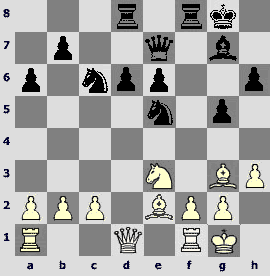
18.Ґh5!N. A strong novelty, White prevents knight transfer via g6 on f4. However, I wrote about this move long ago in the annotations to my own game with Dolmatov. Otherwise one cannot dream about any opening advantage, for example: 18.¦e1 ¤g6 (on 18...d5 there is a possible reply 19.Ґh5) 19.c3 ¤f4 or 18.c3 d5 (here on 18...¤g6 there is a 19.Ґd3! ¤f4 20.Ґc2 d5 21.¦e1 maneuver, and in future one can expect problems on the b1–h7 diagonal) 19.¦e1 (19.¤g4 ¤xg4 20.Ґxg4 e5=; 19.¤c2 ¤g6 20.¦e1 ¤f4=) 19...d4! 20.cxd4 ¤xd4, and Black gets the initiative. Black is also OK after 18.c4 ¤g6! 19.Јd2 ¤f4, as it was in the source Dolmatov-Sakaev game, Moscow 2003. Judging by the reaction, Anand was not well informed.
18...ўh8?! This bracing move is a serious loss of time.
18...d5 19.¦e1 is correct [here 19.a4!? is followed with the important knight transfer 19...¤d7!, and then there is a possibility of, for example, 20.c4 ¤f6 21.cxd5 ¤xh5 22.Јxh5 exd5 with approximate equality or 20.c3 Ґe5 (20...¤c5 21.Ґg6І) 21.Ґxe5 ¤dxe5=] 19...b5!
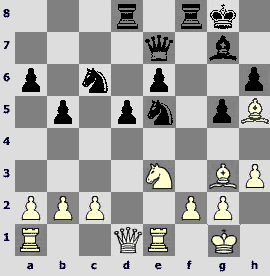
Black provides knight's post on c4. This is exactly what Anand lacked in the game. Subsequent exemplary variations illustrate opponents' chances:
a) 20.¤g4 ¤xg4 (20...¤c4? 21.Јd3‚) 21.Ґxg4 [21.Јxg4 e5 22.¦ad1 (22.h4 e4і) 22...e4 23.c3 Ґe5і] 21...e5 22.a4 b4 23.Јd3 a5 with a good play for Black;
b) waiting 20.ўh1!? is curious;
c) 20.c3 20...d4 21.cxd4 ¤xd4 22.Ґxe5 Ґxe5 23.Јb1 Ґg7 (23...Јh7 24.Ґg6 Јg7 25.¤g4 Ґb8І) 24.¤g4 Јc5 25.Јg6 ўh8 26.ўh1 Јf5 with equality.
19.¦e1 d5 20.a4!
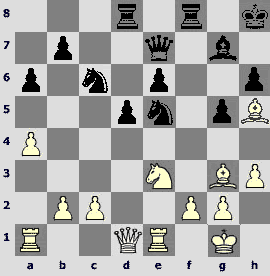
It is a very important move, providing White with the advantage. Now Black cannot play b7-b5, and the a-file opening would be a suicide for him.
20...¤c4?? The only correct move was 20...¤d7!, recommended by Sergey Shipov, attacking the b2-square and at the same time planning to exchange bishops by Ґg7-e5. White still has better chances after 21.c3! (21.¤g4 ¤c5 is not dangerous, transferring the knight to e4; 21.c4 ¤f6 22.cxd5 ¤e4 23.d6 Јd7 24.Ґh2; one need not be afraid of 21.¤xd5 Јc5, with subsequent ¤f6; 21.Ґg6) 21...Ґe5.

Now 22.¤g4 is possible (22.Ґg6!? Ґxg3 23.fxg3 ¤de5 24.Ґc2 d4 25.cxd4 ¤xd4 26.Јh5 ўg7 27.Ґe4 is also interesting) 22...Ґxg3 23.fxg3 ¤f6 (23...¤c5 24.ўh2 ¤e4 25.Јd3, planning to sacrifice on e4 if necessary, 25...Јh7 26.¦f1) 24.¤xf6 Јxf6 25.ўh2. White's chances are better because of the safe king position.
21.¤xc4 dxc4 22.Јg4 Јb4 23.Јxe6 ¦d2 24.¦ad1 ¤d4 25.Јe4ќ. White has a decisive advantage.
B90 Svidler – Topalov, round 5
1.e4 c5 2.¤f3 d6 3.d4 cxd4 4.¤xd4 ¤f6 5.¤c3 a6 6.Ґe3 ¤g4 7.Ґg5 h6 8.Ґh4 g5 9.Ґg3 Ґg7 10.h3 ¤e5 11.¤f5 Ґxf5 12.exf5 ¤bc6 13.¤d5 e6 14.¤e3. 14.fxe6 fxe6 is played more frequently. After that the position can transpose to the game – 15.¤e3 Јa5+ 16.c3 ¤f3+ 17.Јxf3 Ґxc3+ 18.ўd1 Јa4+ 19.¤c2 Ґxb2 etc.
14...Јa5+!? 15.c3
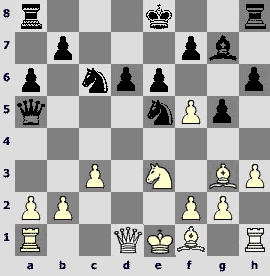
15...¤f3+!?N Previously this idea for Black was used only by a weak chess player, and it was not paid any attention to. Maybe someone will be interested in the way Topalov interprets it...
16.Јxf3 Ґxc3+ 17.ўd1 Јa4+. 17...Ґxb2 leads to a transposition. 18.fxe6 Јa4+! – an important intermediate move! (18...fxe6 leads with moves transposition (White exchanged on e6 on the 14th move) to Cheparinov-Ibarra Jerez game, 2004, which continued 19.¦c1 Ґxc1 20.¤c4 Јxa2 21.Јf6 with White's attack) 19.¤c2 fxe6.
18.¤c2 Ґxb2 19.fxe6 fxe6 20.Јb3. 20.Јg4 ¤d4 21.¦c1 ¦c8 22.Ґd3 ўd7 is dangerous for White, and on 23.¦e1 there is 23...¦c3!
20...Јxb3 21.axb3 Ґxa1 22.¤xa1 ўe7›

It is possible that from this position a new turn of endless theory will begin... And now one can just give the following assessment: it is a double-edged position. Topalov really played perfectly, and he deserved victory in this endgame, but it seems to me that White has better chances in it.
B81 Polgar-Kasimdzhanov, round 3
1.e4 c5 2.¤f3 d6 3.d4 cxd4 4.¤xd4 ¤f6 5.¤c3 a6 6.Ґe3 e6 7.g4 e5 8.¤f5 g6 9.g5 gxf5 10.exf5 d5 11.Јf3 d4 12.0–0–0 ¤bd7 13.Ґxd4 [another well-known attack direction is 13.Ґd2] 13...exd4 14.¦xd4
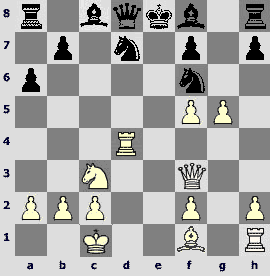
14...Ґg7N. This is a novelty, but obviously an unsuccessful one. Black hopes to castle short, and defend himself under the protection of the dark-squared bishop. Earlier there was 14...Ґc5 15.¦d2 (15.¦d1 Јc7 16.ўb1 Јc6) 15...Јc7 16.gxf6 ¤xf6 17.Ґc4 Ґe7 18.Ґb3 0–0 19.¦e1 ўh8 with unclear position (Pulkkinen-Olle, Helsinki 1990), although White's play can be improved. I think the idea deserving attention for White is not to hurry with taking the f6-knight, which only facilitates Black's development. An interesting choice is for example 15.¦d1 Јc7 16.¤b1!? White indirectly defends from 16...¤e5 (it is followed by 17.Јf4) and suggests Black to express himself. In spite of extra material, it is difficult to play for Black.
15.¦g1! The same idea – it is no use to hurry and capture the f6-knight.
15...ўf8 16.Јe3! Јe7 17.Јd2 h6. It meets the refutation, but it is hard to suggest anything instead.

18.gxf6 ¤xf6 19.¦d8+ ¤e8 20.Ґb5! axb5 21.¦e1 b4, and here 22.¦xe8+ ўxe8 23.¤d5ќwins easily.
21...Ґf6 22.¦xe7 Ґxe7 23.Јd4 f6 24.¤xb5 Ґxd8 25.Јxd8 ўf7 is more stubborn, and here 26.b3 ¦g8 27.ўb2 is the most technical variation. Black has no useful moves, and white queen rages.
The next game is interesting because of the original idea and not the novelty.
B90 Leko-Morozevich, round 2
1.e4 c5 2.¤f3 d6 3.d4 cxd4 4.¤xd4 ¤f6 5.¤c3 a6 6.f3 e6 7.Ґe3 Ґe7 8.Јd2 0–0 9.g4 ¤c6 10.0–0–0 ¤d7 11.h4 ¤de5 12.Јf2 Ґd7 13.ўb1 ¤a5!?N
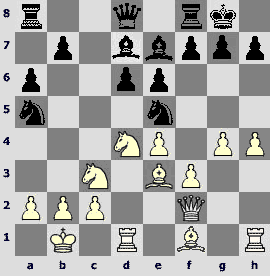
I play the Sicilian all my life, but it is the first time I see such kind of Black's knight development. Morozevich's idea seems very interesting to me.
14.g5 ¤ec4 15.Ґc1. Preventing 15...Јb6 rather than moving the bishop away from the exchange.
15...b5 16.f4 b4 17.¤ce2 Јb6 18.¦h2 [18.Јf3 is also not bad] 18...d5!? 19.exd5 Ґc5 20.Јf3 ¦ad8

Morozevich has reached his main aim – he confused the issue, and after 21.¤b3?! › a complicated position with mutual chances arose. 21.g6 was stronger and more aggressive, but it is not Leko's style, he wants to prepare the g5-g6 move by h4-h5 and f4-f5...
B90 Leko-Topalov, round 1
1.e4 c5 2.¤f3 d6 3.d4 cxd4 4.¤xd4 ¤f6 5.¤c3 a6 6.f3 e6 7.Ґe3 b5 8.Јd2! Leko does not allow Topalov's favorite system 8.g4 h6 9.Јd2 b4 10.Јa4 ¤bd7 to appear.
8...b4?! Topalov badly wants to chase the knight away from c3 as soon as possible. In this version the play with only pawns turned out to be doubtful.

9.¤a4! 9.¤ce2 e5 10.¤b3 ¤c6 11.c4 Ґe7 12.¤g3 g6 13.Ґd3 ¤d7 is passive – white knights are constrained, and they are far away from the d5 square. Black has a nice play (Kramnik-Topalov, Sofia 2005).
9...¤bd7 10.0–0–0 d5 11.exd5! ¤xd5 12.Ґc4! Development is the main issue, it is better not to think about possible bishop exchange.
12...¤7f6 13.Ґg5 Јc7 14.Ґxd5! Here again, the aim is not to lose tempo in retreat. 14...¤xd5 15.¦he1 Ґb7 16.Јe2! Јd6
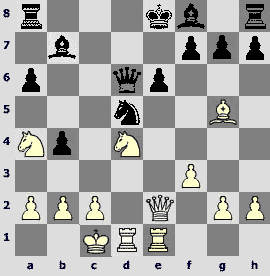
The only protection against 17.¤e6. This position arose in the game. Continuing 17.f4!ќ, White develops a decisive attack.
B90 Svidler-Polgar, round 7
1.e4 c5 2.¤f3 d6 3.d4 cxd4 4.¤xd4 ¤f6 5.¤c3 a6 6.Ґe3 ¤g4 7.Ґg5 h6 8.Ґh4 g5 9.Ґg3 Ґg7 10.h3 ¤e5 11.f3 ¤bc6 12.Ґf2 ¤g6?! Recently popular continuation, but I do not like it – why should the knight be moved away from the centre, is h3-h4 so threatening?
13.Јd2 Јa5 14.0–0–0
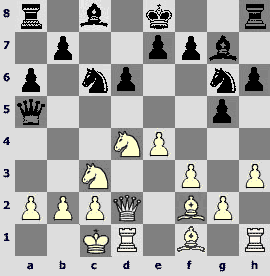
14...Ґd7N [14...Ґe6, which was played earlier, looks more logical] 15.ўb1 [I like 15.Ґc4! ¦c8 16.Ґb3 even more] 15...¦c8 16.g3! In my understanding, it is a punishment for 12...¤g6. Peter is going to undertake f3-f4.
16...¤xd4 17.Ґxd4 Ґxd4 18.Јxd4 Јe5 19.Јf2±
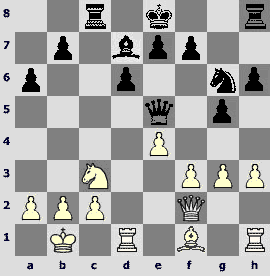
Black has a worse position. An attempt to solve all the collected problems at once does not work:
19...¦xc3 20.bxc3 Јxc3 21.¦d3 Јa5 22.Јe3 Ґe6 23.¦a3 Јb4+ 24.ўa1 ўd7 25.Ґe2 Јc5 26.¦b1!ќ.
B33 Kasimdzhanov-Leko, round 6
1.e4 c5 2.¤f3 ¤c6 3.d4 cxd4 4.¤xd4 ¤f6 5.¤c3 e5 6.¤db5 d6 7.Ґg5 a6 8.¤a3 b5 9.¤d5 Ґe7 10.Ґxf6 Ґxf6 11.c3 0–0 12.¤c2 Ґg5 13.a4 bxa4 14.¦xa4 a5 15.Ґc4 ¦b8 16.¦a2 g6 17.0–0 ўh8 18.b4
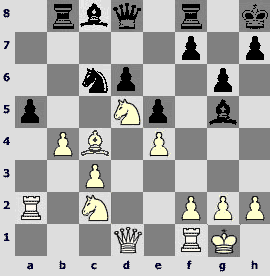
18...Ґd7! 18...axb4 19.cxb4 Ґe6 20.b5 Ґxd5 21.exd5! is strategically unsound (21.Јxd5 ¤e7 22.Јd3 f5! with counterplay), seizing a control over the c6 square. 21...¤a5 22.Ґe2 ¦a8 23.¤b4 ¤b7 24.¦a6! ¤c5 25.¦c6!± Anand-Leko, round 5.
19.Јe2 axb4 20.¤cxb4 [20...f5!? is a good answer for 20.cxb4] 20...¤a5 21.¦fa1 ¤xc4 22.Јxc4 ¦c8 23.Јe2 ¦c5 24.¦a7 Ґe6=
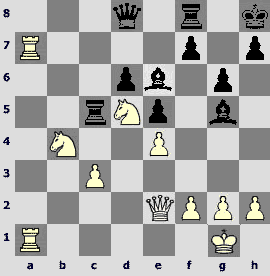
Black is not worse, and even slightly better from my point of view. This assessment concerns even the final position in the game. The main point is not to exchange bishops, even the «bad» dark-squared one.
To be continued.
